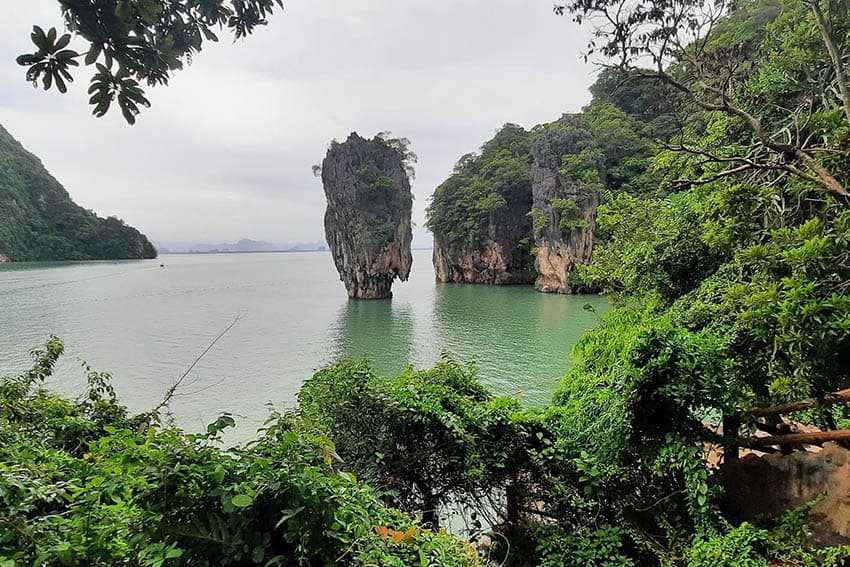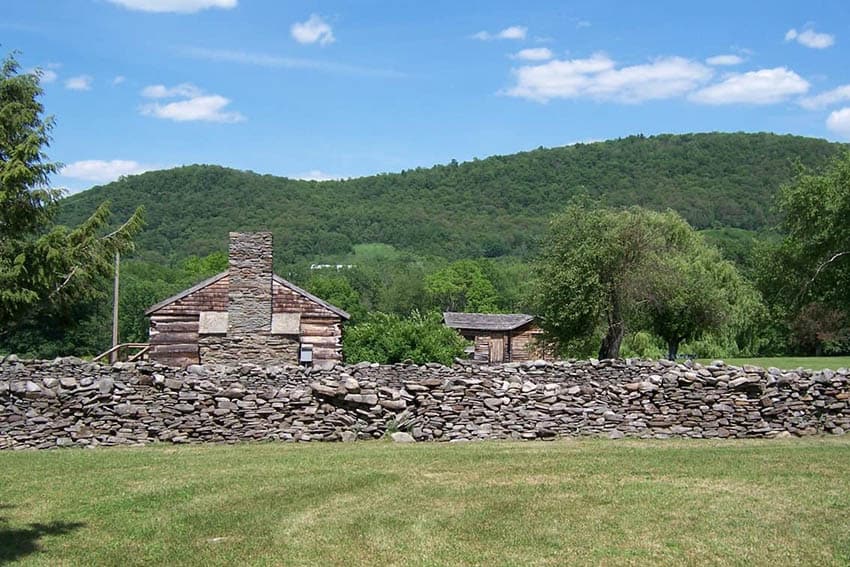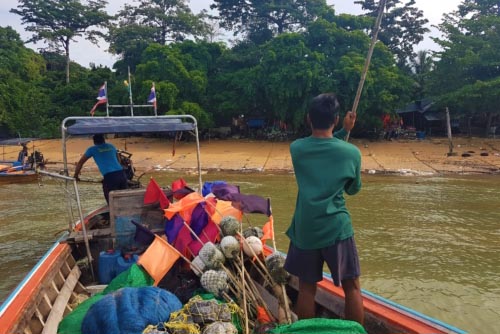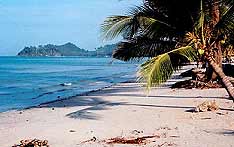 By Ann Moore
By Ann Moore
Most of Thailand, like Isan in the north, was not affected by the killer Tsunami of Dec. 2004. The world’s poorest economies rely on tourism for much of their income….one of the best things you can do to help in this time, is to travel to Asia. —Ed
As we lie on the archetypal beach, the powdery sand between our toes separating the turquoise water from the swaying coconut palms, Koh Chang’s Panviman Resort are faultless. They serve us with exotic, aromatic dishes and chilled green coconuts beneath constantly shifting umbrellas to protect our pink skin from the relentless sun.
“And where are you from?” Bob asks for the third time today. “Isan,” comes the blushing answer yet again.
It seems that Isan, in northeast Thailand, covers almost one-third of the country’s land area and almost the same percentage of population. A chapter from our guidebooks tell us that Isan is traditionally agricultural with evidence going back 7,000 years, despite poor soil and the harsh climate. It has its own dialect and cuisine. It has the finest Khmer ruins outside Cambodia, yet it receives less than 5% of Thailand’s foreign tourists!
Change of Direction
Whilst Koh Chang, an island, is still fairly eco-friendly and development is low-key, it’s still a tourist resort! We book places on the 1-hour, 450 baht minibus transfer for the following morning to take us to Laem Ngop Ferry, then to Trat Airport, where a Toytown runway train takes us to our Bangkok Airways flight. The 40-minute flight flying over the Gulf of Thailand and the endless miles of prawn farms, we arrive to Bangkok.

Across the bridge from the Domestic Terminal is the Don Muang Rail Station, where we purchase Second Class tickets (with fan) for 90 baht to make the 5-hour journey northeast to Bua Yai Junction. The hours fly by due to stops along the way when local vendors display watermelons, flattened chickens on sticks, and sugar cane. At one station, a female strode up and down shouting, “Marzipan in a plastic bag!” It turns out to be Khao Pat Moo (fried rice with pork) delivered at the next station.
A Village From the Past
Waiting for us on the platform are Jim, Lamai (wife), and Lizzie (daughter). From the excitement caused by the arrival of “Farangs,” this is not that common an event.
After 10-15 minutes along a main road flanked by rice fields, we turn off onto an unmade track and bump our way past a farmer leading his buffalos home, a bike carrying two people and a baby, a truck carrying 12-15 people and a pig – all waving and smiling happily. We finally arrive at a beautiful lily-covered lake that lay across from our home for the next few days.
Whilst Jim and Lamai deposit our luggage in our air-conditioned room, Lizzie takes us to meet the “family” – an enormous toad living under a rock by the fishpond, a praying mantis living on the stairs leading to the verandah, a stag beetle living wherever he liked, and numerous geckos and butterflies, attracted by the shrubs and flowers of November.
Back Through the Centuries
As dawn break pinkly over the lake, we wake up to a breakfast of freshly picked bananas from the garden, eggs from a neighbour’s chickens and tasty Thai rice soup. Then off we go for a day of exploring the Khmer ruins at Phimai, the 3000-year-old archaeological remains at Ban Prasat, and the oldest and largest Banyan Tree at Sai Ngam.
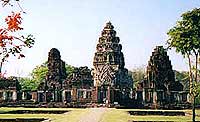
Phimai’s dusky-pink sandstone architecture looks its best in the morning light and the temperature is just right for wandering through the well-preserved temples.
Carvings on the main entrance show the Hindu God Shiva dancing, even though the temple was actually dedicated to Mahayana Buddhism.
We learn that Phimai pre-dates Angkor Wat, and there’s been speculation that it serves as the prototype for Angkor Wat! Perhaps the greatest surprise is the lack of Western faces. We come across a small group of Japanese tourists with their guide and a group of students from Bangkok University.
Then, after a short drive, we see Sai Ngam (Beautiful Banyan). We’ve seen banyan groves before but never anything on this scale. The roots cascade from all but the smallest branches, giving the illusion of a small forest. At various intervals, over small wooden walkways, Buddhist shrines have developed where Thais light candles and make merit. The grove spreads over an island in a large lake, where there are food vendors.
A short visit to Ban Prast, the oldest archaeological site in the Khorat Basin, gives us an insight into an agricultural-ceramic culture from at least 3,000 years ago. The museum shows archaeological evidence of spinning, pottery, and bronze metallurgy. The pottery and skeletons found in the pits are on display, but Lamai is distinctly uneasy – she can feel the presence of its spirits. I had to admit to a certain chill down the spine and was equally glad to leave.
Creepy-Crawlies to Wedding Dresses
Dawn is long gone when we woke up the following day, just in time to take Lizzie to school. All 36 boys and girls try to show us their work at once. Jimmy and Lamai invite donations from their guests to buy colored pencils, books, paper, etc. for the children.
On our return to the house, we notice several village women walking through the garden filling their baskets with mulberry leaves. These are used to feed the silk worms.
In a neighboring village, we visit a working silk village, where at certain times of the year, some of the inhabitants may be rice planting or harvesting in the fields. Today, many were working doing just that. However, a lady villager in her eighties no longer works in the rice fields.
She weaves and breeds silk worms instead.

We follow her through her garden, around the back of her house, and to the “worm house.”
Weaving and Breeding
Here, she shows us the worms eating the mulberry leaves in one basket, and in another, the cocoons from which the silk thread is pulled. Then she leads us over fences to see her neighbor, who sits cross-legged on the floor. She is spinning away, surrounded by several enormous spools of the finished thread.
Back in the village a heavily pregnant woman is weaving with an ancient wooden loom to produce an exquisitely patterned piece of silk cloth. She explains the dyeing process and then shows us where they sell their silk. The village works as a co-operative, so a purchase benefits everybody. Most of the material is sold to Thais and used to make ceremonial costumes and wedding dresses. Visitors are few and far between.
Food, Glorious Food
After the silk village, we return to the Bua Yai market to shop for our evening meal. The content of the market is not unlike that of the floating markets of Bangkok. There are more edible wildlife with lower prices. Apart from an indescribable array of fruit, vegetables, herbs, spices, and fish, there is also a range of caterpillars, beetles and crabs brought in from the paddy fields.
Lamai invites us to choose the ingredients and help prepare for the evening meal. We decide to pass on the insects, and buy two large freshwater fish for the barbecue, as well as for the ingredients to make green curry.
Because Ko Phet is a rice village, most of the inhabitants work in the fields. Those who cannot, for reasons of health or age, usually find other ways of making a few baht. One of them called on us as we prepare the barbecue. She makes “puddings” and brought along a basket containing a choice of three of her most popular. All were presented in small square packets made of banana leaves and stapled together. We taste them out of politeness.
In an hour, we pick fresh garden papaya for the Isan “bok-bok,” barbecue the spiced fish, boil the huge cauldron of rice, and prepare the green curry in the kitchen. I learn how to make curry paste to my liking. They warn us about the “bok-bok,” and postpone its tasting. As Lamai eats it, tears run down her face. “Why do you eat it?” We ask. “I like it,” her instant reply.
What We Learned
Listening to the tales of country life, superstitions, and myths passed down from one generation to another, we learn about the local rain-making ceremonies, the traditions associated with weddings, births and deaths. We also learn about the government’s efforts in bringing revenue to the area, the fear that the rice fields won’t sustain the farmers for much longer, the attempts at promoting sustainable tourism and the inevitable loss of young people year by year.
Hopefully, Isan will attract a greater share of Thailand ’s tourists in the future. We will return next year, but for a longer time. We have barely scratched the surface!
For more information:
- These 9 U.S. National Parks Require Reservations in 2024 - April 17, 2024
- Take a Hike in Olympic National Park - April 17, 2024
- The Wild Mississippi: 2340 Miles Across Ten States - April 8, 2024



